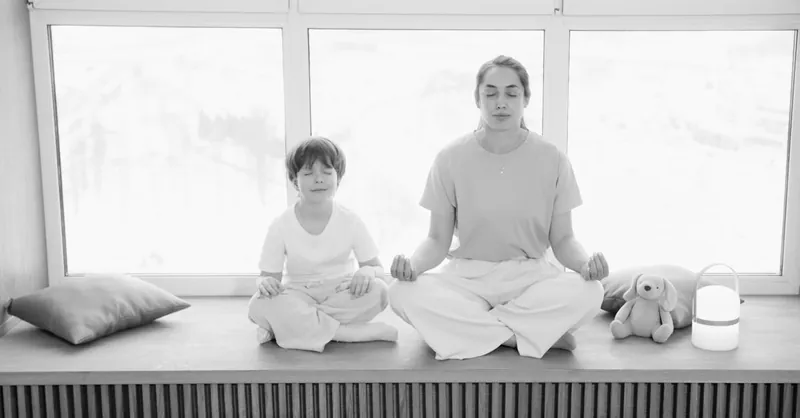Simplifying Parenting with Minimalism: Practical Steps
Category: Lifestyle
Simplify Parenting Through Minimalism: A Clear Path Forward
Parenting in today’s fast-paced world can feel overwhelming, filled with constant demands, clutter, and pressure to do it all. If you’re here, you likely already understand the benefits of minimalism or are curious about how embracing it can make your parenting experience more joyful and manageable. Maybe you’re a busy parent seeking practical ways to reduce the noise—both physical and mental—so you can focus on what truly matters: your family’s well-being and connection. You don’t need generic advice but actionable, clear guidance tailored to your lifestyle and challenges. This post cuts through the fluff and dives deep into how minimalism isn’t just about having fewer toys or possessions, but about simplifying routines, decluttering emotional stress, and finding balance in parenting. Unlike many posts that skim the surface, you’ll discover a logical, step-by-step framework and insights on integrating minimalism into every aspect of parenting—from managing toys and schedules to nurturing mindful relationships. Whether you’re new to minimalism or looking for fresh inspiration to sustain it in your busy family life, this guide is your go-to resource for clarity and fulfillment in parenting.
- Simplify Parenting Through Minimalism: A Clear Path Forward
- Understanding Minimalism in the Context of Parenting
- Decluttering Your Child’s Environment: Strategies to Foster a Calm and Safe Living Space
- Simplifying Daily Routines and Schedules: Creating Manageable Rhythms for Family Harmony
- Mindful Parenting Practices: Cultivating Presence, Patience, and Emotional Clarity
- Adopting Minimalist Values in Education and Activities: Choosing Quality Over Quantity
- Streamlining Meal Planning and Family Nutrition: Tips for Simple, Healthy Meals
- Managing Technology Use Thoughtfully: Guidelines for Minimal Screen Time and Intentional Tech Use
- Financial Minimalism for Families: Practical Budgeting and Teaching Mindful Spending
- Building a Support System that Aligns with Minimalism: Encouraging Like-Minded Communities for Simplified Parenting
- Sustaining Minimalism as Your Family Grows: Adapting Minimalist Principles Through Life’s Transitions
Understanding Minimalism in the Context of Parenting
Minimalism for parents goes beyond simply owning fewer items—it's a mindful approach to family life that prioritizes what truly matters, fostering an environment where both parents and children can thrive. At its core, minimalism in parenting means intentionally reducing physical clutter, limiting distractions, and streamlining routines so that your family can focus on meaningful connections and purposeful activities. This philosophy encourages parents to carefully evaluate possessions, commitments, and even emotional baggage, consciously choosing simplicity over excess.
Key Benefits of Minimalist Parenting
-
Reduced Stress and Overwhelm
By minimizing toys, clothes, and household items, parents create calmer spaces that are easier to manage and clean. This reduction in physical clutter also translates to decreased mental clutter, helping parents feel less overwhelmed by daily demands. -
More Intentional Time with Family
Simplifying schedules and commitments allows parents to be truly present, dedicating quality time to connect with their children instead of rushing through to-do lists. Minimalism helps clarify priorities so you can focus on activities that nurture your relationships and values. -
Improved Family Dynamics
With fewer distractions and more open space—both physically and emotionally—families experience enhanced communication, cooperation, and harmony. Children benefit from stable routines and clear boundaries, while parents feel empowered to lead by example in practicing mindful living.
Embracing minimalism in parenting is not about perfection but about making deliberate choices that bring clarity, balance, and deeper joy to everyday family life. It’s a sustainable way to reduce the chaos and cultivate a nurturing environment that supports growth and well-being for every family member.

Image courtesy of Photo By: Kaboompics.com
Decluttering Your Child’s Environment: Strategies to Foster a Calm and Safe Living Space
Creating a calm, clutter-free environment for your child is a foundational step in simplifying parenting through minimalism. A streamlined space not only eases daily routines but also promotes focused play and learning, enabling your child to thrive emotionally and mentally. The key lies in thoughtfully managing toys, clothes, and belongings—choosing quality over quantity and ensuring everything in your child’s space serves a meaningful purpose.
Practical Strategies to Declutter Toys, Clothes, and Belongings
-
Conduct a "Keep, Donate, Discard" Sort
Set aside regular intervals (seasonally or biannually) to review your child’s toys and clothes. Categorizing items into what to keep, donate, or discard helps prevent accumulation of unnecessary belongings. Focus on keeping toys that encourage creativity or skill-building, and clothes that fit well and are seasonally appropriate. -
Implement Toy Rotation Systems
Instead of overwhelming your child with a large number of toys all at once, use a rotation system where only a small selection is accessible at a time. This reduces clutter, extends the life of toys, and helps children engage more deeply with each item, fostering imaginative and focused play. -
Designate Clear Storage Solutions
Use simple, clearly labeled storage bins or shelves tailored to your child’s height and abilities. This encourages independence in tidying up while maintaining organization. Open storage encourages visibility and choice, whereas closed storage hides clutter while promoting a peaceful space. -
Adopt a One-In, One-Out Rule
To maintain balance over time, introduce a rule where a new toy or piece of clothing only enters the home when an old one is donated or discarded. This habit reinforces mindful consumption, preventing the build-up of excess items and teaching children about valuing possessions responsibly. -
Create Zones for Different Activities
Define areas within your home dedicated to play, learning, and rest. Limiting toys and materials to their appropriate zones reduces distractions and helps children transition between activities more smoothly, supporting better focus and calming overstimulation.
By deliberately decluttering and organizing your child’s environment, you foster a safe, serene atmosphere that supports their growth and concentration. Embracing these strategies aligns with the minimalist parenting philosophy, emphasizing intention and simplicity to nurture children’s independence and emotional well-being within a clutter-free, harmonious home.

Image courtesy of Curtis Adams
Simplifying Daily Routines and Schedules: Creating Manageable Rhythms for Family Harmony
One of the most transformative benefits of minimalist parenting lies in streamlining daily routines and schedules to reduce overcommitment and create space for meaningful family moments. Overloaded calendars and chaotic mornings not only increase stress but also diminish quality time, making it difficult for parents and children to connect authentically. By adopting intentional, simplified rhythms tailored to your family’s natural flow, you can foster consistency, reduce decision fatigue, and cultivate a calm home environment where everyone thrives.
How to Build Manageable Daily Rhythms
-
Prioritize Core Activities
Focus on a few essential daily activities that support your family’s health and happiness, such as shared meals, bedtime rituals, and designated play or learning time. Eliminating unnecessary obligations ensures these moments receive your full attention and energy. -
Implement Time Blocks Instead of Minute-by-Minute Schedules
Rather than rigidly scheduling every minute, use flexible time blocks (e.g., morning, afternoon, evening) to accommodate natural fluctuations in energy and mood. This approach respects individual rhythms while maintaining structure and predictability for children. -
Limit Extracurricular Commitments
Be selective about after-school activities or social events, choosing only those that align with your family values and interests. A minimalist schedule encourages deeper engagement in fewer pursuits, reducing overwhelm and burnout. -
Create Simple, Visual Schedules
Use clear, easy-to-understand visuals such as charts or calendars to outline daily rhythms for your children. Visual cues help reduce anxiety around transitions and empower kids to anticipate what comes next, fostering independence and cooperation. -
Build in Buffer and Transition Times
Include intentional breaks between activities to prevent rushing and allow time for relaxation or spontaneous play. Buffer periods ease transitions and promote a slower, more mindful pace that benefits both parents and children.
Simplifying routines through these strategies leads to less chaos and more meaningful interactions, turning everyday moments into opportunities for connection and growth. When your family thrives on intentional rhythms rather than frantic hustle, parenting becomes not just manageable but deeply rewarding. Embracing this minimalist approach to scheduling frees up precious time and mental space, allowing your family to savor the present rather than scramble toward the next task.

Image courtesy of Vitaly Gariev
Mindful Parenting Practices: Cultivating Presence, Patience, and Emotional Clarity
Adopting a minimalist mindset in your parenting interactions and discipline transforms how you engage with your children, fostering deeper emotional connections through intentional presence and patience. Mindful parenting encourages you to slow down, fully observe your child’s needs and behaviors without distraction, and respond with clarity rather than reaction. This approach simplifies emotional dynamics by eliminating the noise of guilt, over-scheduling, and impulsive responses, making space for calm, consistent guidance and open communication.
Core Principles of Mindful Minimalist Parenting
-
Prioritize Presence Over Perfection
Strive to be fully present during your interactions—put away devices, quiet external distractions, and focus entirely on your child. This presence nurtures trust and emotional security, enabling children to feel genuinely seen and heard. -
Practice Patience Through Intentional Breathing and Reflection
When tensions arise, pause and breathe deeply before responding. This deliberate pause reduces impulsive discipline and models emotional regulation, helping both parent and child navigate challenges with patience and respect. -
Set Clear, Simple Boundaries
Minimalism in discipline means establishing a few essential, consistent rules rather than overwhelming children with too many restrictions. Clear boundaries foster emotional clarity and security, allowing children to understand expectations without confusion. -
Engage in Active Listening and Validate Emotions
Give children space to express their feelings openly. Reflect back what you hear and validate their emotions without immediately trying to fix or dismiss them. This habit strengthens emotional intelligence and mutual respect. -
Embrace Quality Over Quantity in Interactions
Focus on the quality of your moments with your child rather than the length or number of interactions. Small, meaningful exchanges imbued with attention and empathy often have a greater impact than lengthy but distracted parenting efforts.
By internalizing these mindful parenting practices, families create an environment rich in emotional clarity and connection. Minimalism thus extends beyond physical decluttering into the realm of relationships—reducing stress, enhancing understanding, and nurturing a more compassionate, patient family dynamic. This mindful simplicity supports your child's emotional growth and well-being while empowering you as a calm, attentive, and loving parent.

Image courtesy of Artem Podrez
Adopting Minimalist Values in Education and Activities: Choosing Quality Over Quantity
Incorporating minimalist principles into your child’s education and extracurricular activities is essential for preventing overwhelm and promoting balanced development. Instead of overloading children with multiple classes, enrichment resources, or endless learning tools, minimalist parenting encourages focusing on quality experiences that truly enrich your child’s growth and curiosity. By carefully selecting a few meaningful extracurriculars and educational materials, you create space for deep engagement, reduce stress for both parents and children, and foster intrinsic motivation rather than burnout.
How to Choose Quality Over Quantity in Learning Resources and Activities
-
Assess Your Family’s Core Values and Interests
Begin by identifying the activities and learning areas that resonate most with your family’s values and your child’s natural passions. This ensures that chosen commitments align with authentic interests, enhancing enjoyment and long-term participation. -
Limit Extracurriculars to One or Two Thoughtfully Selected Pursuits
Rather than spreading your child across multiple activities, select one or two high-quality programs that offer opportunities for skill-building, creativity, or social connection. This focused approach prevents overscheduling and encourages mastery and confidence. -
Invest in Versatile, Open-Ended Learning Materials
Choose educational resources like books, puzzles, or art supplies that foster open exploration and critical thinking rather than passive consumption. Minimalism values materials that adapt to a child’s evolving interests and developmental stages. -
Create Unstructured Time for Free Play and Discovery
Balancing structured activities with ample free time allows children to practice self-directed learning and creativity. Minimalist education recognizes that some of the most meaningful growth happens in moments of unpressured play and reflection. -
Regularly Reevaluate and Adjust Commitments
As children grow and interests shift, periodically review extracurricular activities and learning tools to ensure they still serve your child’s development without causing overwhelm. Letting go of less meaningful commitments is a key aspect of maintaining simplicity and focus.
By embracing quality over quantity in education and extracurricular activities, minimalist parenting fosters an environment where children thrive without the burden of an overpacked schedule or excessive resources. This intentional approach reduces stress, enhances learning, and nurtures a joyful, balanced family life centered on presence and purposeful growth.

Image courtesy of Ksenia Chernaya
Streamlining Meal Planning and Family Nutrition: Tips for Simple, Healthy Meals
Meal planning is often a major source of stress for busy parents, but embracing minimalism in family nutrition can transform mealtimes from chaotic to calm, nourishing both body and mind with less prep time and overwhelm. The key is to focus on simple, wholesome meals using versatile ingredients, reducing decision fatigue and clutter in the kitchen while ensuring your family enjoys balanced nutrition.
Practical Tips to Simplify Meal Planning and Preparation
-
Create a Rotating Meal Schedule
Develop a small repertoire of easy, nutritious meals that rotate weekly. This reduces grocery shopping complexity and helps streamline cooking routines without sacrificing variety. Focus on recipes featuring whole grains, lean proteins, fresh vegetables, and seasonal produce. -
Batch Cook and Use Leftovers Intentionally
Set aside time for batch cooking staple items such as grains, beans, or roasted vegetables. Repurpose leftovers creatively for lunches or next-day dinners to save time and minimize food waste. -
Embrace One-Pot or Sheet-Pan Meals
Opt for recipes that minimize cookware and hands-on time, such as soups, casseroles, or sheet-pan dinners. These meals simplify cleanup while delivering balanced nutrition efficiently. -
Limit Ingredients and Keep Pantry Staples Versatile
Stock your pantry and fridge with a curated selection of multi-use, healthy ingredients (e.g., canned tomatoes, frozen vegetables, whole-grain pasta, nuts). Having these essentials on hand supports quick meal assembly without frequent grocery trips. -
Encourage Family Involvement
Invite children to participate in simple meal prep tasks suited to their age, like washing vegetables or assembling salads. This fosters connection, teaches healthy habits, and distributes workload, making mealtimes more enjoyable. -
Plan for Snacks That Nourish
Replace processed snack options with healthy, minimal-ingredient choices such as fresh fruit, yogurt, nuts, or cut veggies. Preparing snack-sized portions in advance cuts down on decision-making during busy moments.
By simplifying meal planning and focusing on wholesome, minimal-ingredient meals, you reduce kitchen clutter, stress, and time spent cooking, allowing for more relaxed family meals and better nourishment. This minimalist approach fosters a positive food environment where healthy habits flourish naturally, supporting your entire family’s well-being with ease and intention.

Image courtesy of MART PRODUCTION
Managing Technology Use Thoughtfully: Guidelines for Minimal Screen Time and Intentional Tech Use
Incorporating technology mindfully within your family life is a crucial aspect of simplifying parenting through minimalism. With digital distractions omnipresent, managing screen time intentionally helps transform technology from a potential source of chaos into a supportive tool for connection and learning. Rather than allowing devices to dominate daily rhythms, minimalist parenting encourages thoughtfully setting boundaries that prioritize meaningful family interactions and purposeful educational use.
Strategies for Mindful Technology Use in Families
-
Set Clear Boundaries on Screen Time
Establish consistent limits tailored to your child’s age and needs, balancing digital activities with offline play and real-world experiences. Recommended guidelines from pediatric experts can serve as a reference, but customizing boundaries to fit your family dynamics ensures sustainable habits. -
Use Technology as a Tool, Not a Default Entertainment
Choose apps, games, and shows that foster creativity, problem-solving, or learning rather than passive consumption. Encourage your child to engage with tech intentionally—such as interactive storytelling or educational videos—rather than using devices as mere distractions. -
Create Screen-Free Zones and Times
Designate specific areas (like bedrooms or dining tables) and periods (such as family meals or before bedtime) as technology-free to nurture face-to-face communication and restful routines. This practice protects essential moments for bonding and emotional presence. -
Co-Engage with Tech Together
Participate alongside your child during screen time to model balanced use and turn digital interactions into opportunities for shared learning and discussion. Co-viewing or co-playing can deepen connection and help you guide your child’s understanding of content. -
Encourage Alternatives to Screens
Offer engaging offline activities—like reading, outdoor play, or creative arts—that naturally draw interest away from digital devices. When children have access to enriching alternatives, screen time becomes a deliberate choice rather than default behavior.
By managing technology use thoughtfully, minimalist parenting reduces digital clutter and overstimulation, fostering an environment where devices serve your family’s well-being instead of undermining it. This approach supports clearer boundaries and enhances opportunities for genuine connection and mindful growth, making tech a balanced part of your simplified family lifestyle.

Image courtesy of Kampus Production
Financial Minimalism for Families: Practical Budgeting and Teaching Mindful Spending
Embracing financial minimalism is a powerful step toward simplifying parenting and creating a balanced family life. By intentionally managing your family’s budget and reducing unnecessary expenses, you not only alleviate monetary stress but also model mindful money habits for your children. Financial minimalism encourages focusing spending on what truly adds value and joy to your family’s life, cutting out impulsive purchases and consumer-driven pressure that often complicate parenting.
Practical Tips for Budgeting and Reducing Expenses
-
Create a Clear, Realistic Family Budget
Start with a transparent overview of your income, fixed expenses (housing, utilities, groceries), and discretionary spending. Use simple budgeting tools or apps to track and categorize expenses, helping you identify areas where you can cut back without sacrificing essentials. -
Distinguish Needs from Wants
Before making purchases, pause to evaluate whether the item serves a practical purpose or simply satisfies an impulse. Encouraging this practice reduces clutter and aligns spending with your family’s core values. -
Implement a Waiting Period for Non-Essential Purchases
Introduce a rule of waiting 24-48 hours before buying non-essential items. This cooling-off period curbs impulse buying and allows time to reflect on whether the purchase genuinely benefits your family. -
Opt for Quality Over Quantity
Invest in durable, multifunctional items that last longer and offer better value instead of frequently buying cheaper, disposable products. This principle applies to clothing, toys, and household goods alike, contributing to fewer replacements and less waste. -
Automate Savings and Bill Payments
Set up automatic transfers to savings accounts and schedule bill payments to avoid late fees and ensure consistent financial discipline. Automating these processes reduces mental clutter and prevents common financial pitfalls.
Teaching Children Mindful Spending Habits
Cultivating financial awareness in children is essential for fostering responsible, minimalist values that will serve them throughout life. Introducing age-appropriate financial lessons empowers kids to understand the value of money and appreciate thoughtful consumption.
-
Use Clear Allowance Systems: Give children small amounts of money with guidelines on how to save, spend, and share, helping them experience budgeting firsthand.
-
Discuss Money Openly and Positively: Normalize conversations about family finances, explaining why certain spending choices are made, which demystifies money and reduces anxiety.
-
Encourage Saving for Goals: Help children set simple savings goals for desired toys or experiences to teach patience and delayed gratification.
-
Model Mindful Purchasing Decisions: Involve children when shopping to compare options, discuss quality versus price, and question the necessity of items.
-
Celebrate Experiences Over Things: Shift focus from accumulating possessions to valuing memories and shared activities, strengthening family bonds without increasing spending.
By integrating financial minimalism into your family’s lifestyle, you create a sustainable foundation for emotional and material well-being. Simplifying spending habits reduces stress, frees up resources for meaningful experiences, and nurtures a generation of mindful, financially savvy individuals grounded in purposeful living.

Image courtesy of Photo By: Kaboompics.com
Building a Support System that Aligns with Minimalism: Encouraging Like-Minded Communities for Simplified Parenting
Creating a strong, supportive network is essential when embracing minimalist parenting, as the journey toward simplicity is often easier and more sustainable when shared with like-minded individuals. Building a support system that aligns with minimalist values helps reinforce your commitment to reduced clutter, mindful consumption, and intentional living, while providing encouragement, practical advice, and emotional support. Surrounding yourself with other parents who prioritize simplicity nurtures resilience against societal pressures and consumer-driven norms that often overwhelm families.
How to Cultivate and Engage Minimalist Parenting Communities
-
Seek Out Local Minimalist or Simplified Living Groups
Many communities now host meetups or workshops focused on minimalism and intentional living. Participating in these gatherings provides opportunities to exchange ideas, share resources like secondhand kids’ gear, and offer mutual support for simplifying parenting challenges. -
Join Online Minimalist Parenting Forums and Social Media Groups
Online platforms like Facebook, Reddit, or specialized parenting websites have active minimalist parenting groups where members discuss decluttering strategies, mindful education, and balanced family rhythms. These virtual communities are invaluable for real-time problem-solving and inspiration. -
Collaborate on Minimalist Playdates and Resource Sharing
Encourage shared playdates with families aligned around minimalist values to reduce toy overload and promote social interaction through simple, creative play. Setting up toy swaps or clothing exchanges strengthens community bonds and supports sustainable consumption. -
Engage in Honest Conversations About Minimalism’s Benefits and Challenges
Open dialogues with friends, family, and fellow parents foster understanding and often encourage others to explore simplicity in their own parenting. Sharing experiences about overcoming clutter, managing schedules, and reducing stress highlights the practical impact of minimalist choices. -
Utilize Community Resources That Support Simplified Living
Libraries, community centers, and local parenting groups often provide free or low-cost programs promoting quality family time and skill-building without excess consumerism. Leveraging these resources minimizes financial strain and enriches your minimalist lifestyle.
By intentionally cultivating connections with like-minded parents and communities, you surround your family with positive reinforcement that sustains your minimalist parenting goals. This aligned support system not only eases the practical aspects of simplification but also nurtures emotional wellbeing, creating a strong foundation for joyful, intentional family life free from excess noise and clutter.

Image courtesy of Pavel Danilyuk
Sustaining Minimalism as Your Family Grows: Adapting Minimalist Principles Through Life’s Transitions
Maintaining a minimalist lifestyle while your family evolves is a dynamic process that requires flexibility and intentional adaptation to meet shifting needs at different stages of child development. As children grow from infants to toddlers, school-age kids, and eventually teenagers, your parenting approach and household organization must evolve without losing sight of core minimalist values. This ongoing adjustment ensures that simplicity remains a sustainable foundation rather than a fleeting phase.
Key Strategies for Adapting Minimalism Through Childhood Stages
-
Infancy and Toddlerhood: Focus on Essentials and Safety
During early years, prioritize owning only the most necessary items—quality clothing, safe toys, and basic gear that facilitate comfort and development. Minimizing excess helps reduce overwhelm, making daily care manageable while establishing clear routines. Frequent decluttering is especially helpful, as babies quickly outgrow items. -
Preschool and Early School Years: Encourage Independence Through Organized Spaces
As children gain mobility and autonomy, adapt minimalist organization to support self-care and responsibility. Design storage at child height and rotate toys to keep engagement high without clutter. Limit new acquisitions to items that promote creativity or learning, ensuring a peaceful environment conducive to focus and rest. -
Tweens and Teens: Emphasize Values and Emotional Minimalism
Older children often accumulate more belongings and experience complex emotions. Shift the minimalist approach to prioritize emotional clarity, reducing pressure around material possessions and encouraging thoughtful decision-making about what they keep and why. Engage teens in budgeting and mindful consumption conversations, fostering responsible independence that aligns with family values. -
Reevaluate Commitments Regularly
With growing children, schedules tend to become busier and more complex. Sustain minimalism by periodically reviewing extracurriculars, social activities, and family obligations. Eliminate or pause commitments that no longer serve your family’s well-being, maintaining manageable rhythms and reducing stress. -
Adapt Routines and Spaces Mindfully
As daily needs evolve—from nap schedules to homework zones—approach changes with intention. Simplify transitions by decluttering outdated items and redesigning spaces to fit current activities and developmental stages, avoiding accumulation of unused or redundant belongings.
Sustaining minimalism as your family grows is a journey of continual reevaluation and mindful adjustment. By staying attuned to your children’s developmental needs and evolving family dynamics, you preserve the clarity, calm, and focus that minimalism offers amidst life’s natural changes. This adaptive minimalism not only reduces physical and mental clutter but also cultivates a resilient, joyful family culture grounded in simplicity and intentional living.

Image courtesy of Ron Lach
